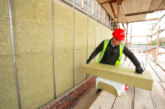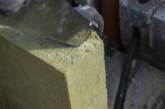
Alun Price, Product Manager at Isover UK, discusses how to improve acoustic performance in a building and outlines the commercial benefits for housebuilders.
In Britain, today’s homes can be very noisy spaces. This is especially true in households that contain occupants from multiple generations. The Office for National Statistics now claims that about a quarter of young adults in the UK are still living with their parents – the highest number since records began. While noise from other occupants in a home is a natural part of being a family, excess levels of sound have been proven to have a significant and detrimental effect on overall comfort levels.
Health and wellbeing is increasingly influencing decision making in the UK’s property market and – according to Saint-Gobain’s UK Home, Health and Wellbeing report – unwanted noise is in the top 10 list of residential concerns in Britain. In the last decade, the number of British people choosing to work from home has risen by a fifth, reaching a record 1.5m. However, the Government’s most recent National Noise Attitude Survey suggests that almost half (48%) of people feel their home life is spoilt to some extent by noise.
 Measuring noise
Measuring noise
Taking these findings into account, it seems residential sound control is now extremely important to homeowners and that a building’s level of noise transference is often used as a measure of quality. In fact, the Saint-Gobain survey suggests goes as far as suggesting that devices that measure ambient noise in a home – much like an air quality monitor or thermostat – could soon be common pieces of technology located in British properties.
Acoustic performance is covered by Building Regulations Part E (England and Wales) and Section 5 (Scotland) which set the minimum standards for sound reduction and absorption qualities in new structures. However, as is often the case when any minimum value is specified, there can be a tendency to meet this level rather than exceed it.
To ensure their properties meet the health and wellbeing needs of their customers, housebuilders should prioritise appropriate acoustic performance when specifying for construction materials. There are ways that homeowners can strengthen the acoustic integrity of a home. However, if housebuilders make the right decisions during the early stages of a development, this can eliminate the need for costly retrofits.
Improved acoustics
Glass mineral wool insulation is traditionally viewed as a solution that primarily affects the thermal integrity of a property. However, high performing insulation products – such as Isover’s glass mineral wool solutions – can also play a vital role in boosting acoustic performance.
Specialist mineral wool acoustic insulation can be manufactured to the optimum density for efficiently dampening sound and reducing its transfer between walls and floors. Isover’s solutions are also available in thicknesses and widths which are appropriate for residential applications, ensuring effective performance and easier to install solutions.
Isover’s Acoustic Partition Roll (APR), for example, plays a major role in reducing the transmission of airborne sound from one room to another and features in internal walls systems that offer acoustic performance up to 70dB (Rw). When used between a property’s joists, it will also significantly dampen noise transference between floors, ensuring comfort for occupants on different levels.
For separating walls, RD Party Wall Roll (masonry) and Timber Party Wall Roll/Timber Frame Batt (timber frame) are specifically created to reduce the transmission of airborne sound between connected properties, while contributing to optimal thermal and fire separation.
Ahead of the competition
Over the next five years, ambitious government housebuilding targets will undoubtedly result in a more competitive market and high demands on the sector. By making use of the most effective acoustic insulation products, housebuilders can futureproof their projects, allowing them to stand out from the competition in an increasingly health and wellbeing conscious world.








